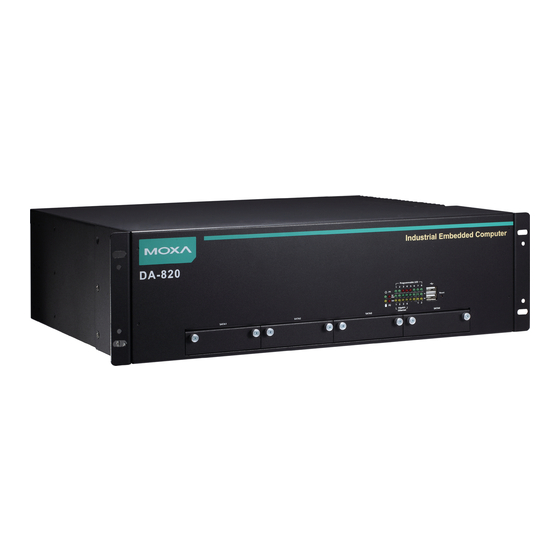Table of Contents
Advertisement
Quick Links
DA-820 Series
Rackmount Computer
Quick Installation Guide
First Edition, October 2014
Overview
The DA-820's main operating system is based on the lntel Core i7
CPU and QM77 chipset, which supports standard x86 platform. The
DA-820 has 2 VGA connections, 6 USB ports, 4 Gigabit LAN ports,
and 2 RS/232/422/485 3-in-1 serial ports, and is equipped with a
4 SATA disk interface and default support for RAID 0/1/5/10. In
addition, the DA-820 is specifically designed for substation
applications that require precise time synchronization and
products meeting the IEC 61850-3 standard. The flexible design
makes the DA-820 suitable for local SCADA, environmental
monitoring, video surveillance, protocol conversion, and PRP/HSR
redundancy applications, and the cybersecurity functionality
allows you to maintain secure network communications.
Package Checklist
Each basic system model is shipped with following standard items:
•
DA-820 rackmount computer
•
Rackmount kit
•
Quick Installation Guide
•
Documentation and software CD
•
Warranty card
Hardware Installation
Front View
P/N: 1802008200010
– 1 –
Rear View
*The power input supports two types of power supply:
HV: 100 to 240 VAC/VDC
LV: 24 to 110 VDC
Connecting the Power
Use a screwdriver to loosen the terminal connector's clamp screws.
Connect the power cord wires to the screws, and then retighten the
screws. The Power LED will light up to indicate that power is being
supplied to the DA-820, after which the BIOS will initialize the flash
disk module, causing the Storage LED to blink. It should take
about 30 to 60 seconds for the operating system to complete the
boot process.
Alternating Current (AC),
Alternating Current (AC),
Single Power
Dual Power
Direct Current (DC),
Direct Current (DC),
Single Power
Dual Power
– 2 –
For more detailed power connection and surge protection
information, refer to the Hardware User's Manual.
Front Panel LEDs
There are 28 LED indicators on the front panel. The LEDs are
described in the following table.
LED
Color
Description
Power
Green
Power is on
Off
No power input or power error
exists
Storage
Yellow/
Data is being written to or to read
Blinking
from the storage unit
Off
Storage unit is idle
P1
Off
The 1st power in on
(Non-functional for
Red
Error in the 2nd power supply
single power supply)
P2
Off
The 2nd power is on
(Non-functional for
Red
Error in the 1st power supply
single power supply)
Gigabit LAN LEDs
Green
100 Mbps Ethernet mode
1-4
Orange
1000 Mbps (Gigabit) Ethernet
mode
Serial Port 1/2
Green
Tx
Yellow
Rx
Programmable 1-8
Green/
1-8 programming action is in
Blinking
process
Connecting to a Display
The DA-820 comes with 2 VGA interfaces that use D-Sub 15-pin
female connectors.
USB Ports
The DA-820 comes with 6 USB 2.0 ports, with 4 on the rear panel
and 2 on the front panel. The USB ports can be used to connect a
keyboard, mouse, or other peripherals, such as flash drives for
expanding the system's storage capacity.
– 3 –
Advertisement
Table of Contents

Subscribe to Our Youtube Channel
Summary of Contents for Moxa Technologies DA-820 Series
-
Page 1: Package Checklist
Rear View DA-820 Series Rackmount Computer For more detailed power connection and surge protection Quick Installation Guide information, refer to the Hardware User’s Manual. Front Panel LEDs First Edition, October 2014 There are 28 LED indicators on the front panel. The LEDs are described in the following table. -
Page 2: Configuring The Ethernet Interface
Serial Ports Win7 users should follow these steps: Configuring the Ethernet Interface The DA-820 comes with 2 software-selectable RS-232/422/485 Step 1: Go to Start Control Panel Network and Internet serial ports on the rear panel. The ports use DB9 male connectors. Linux users should follow these steps: ...














Need help?
Do you have a question about the DA-820 Series and is the answer not in the manual?
Questions and answers